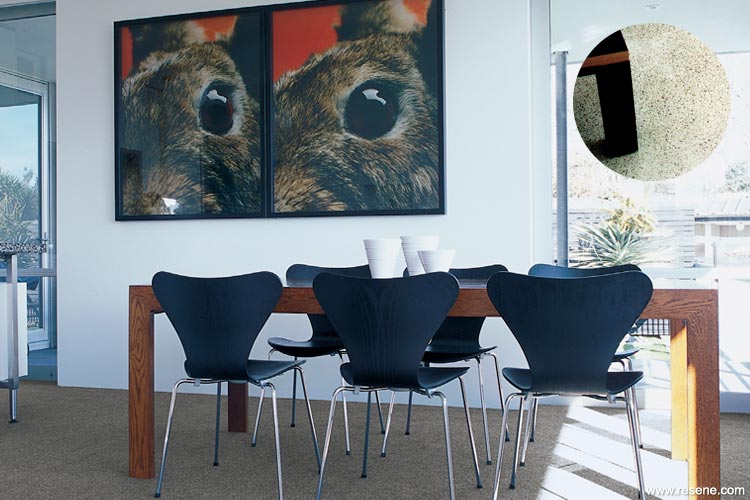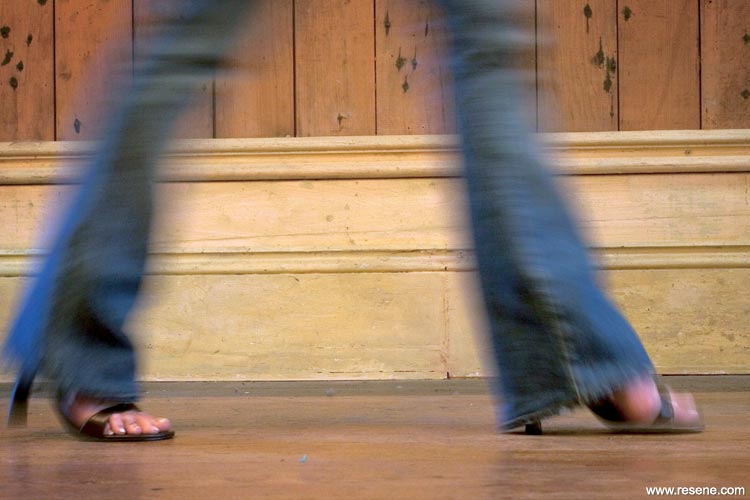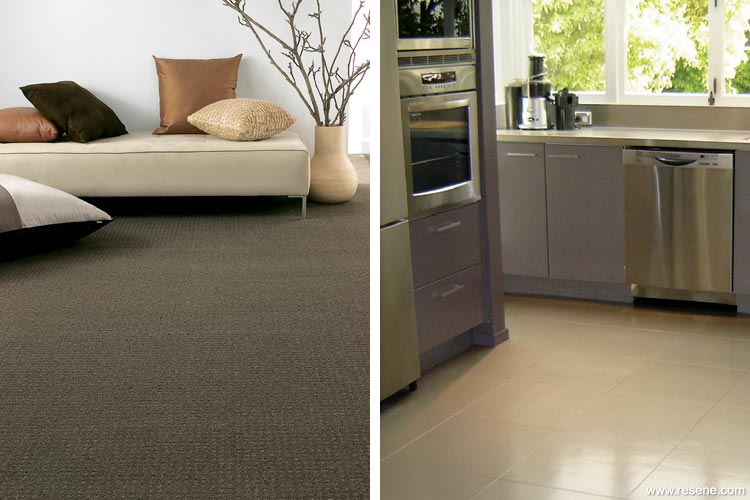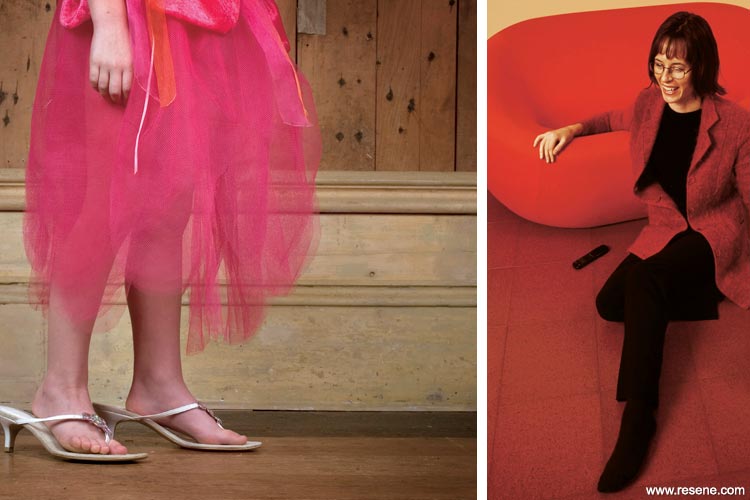From Habitat magazine - issue 03
When it comes to flooring, it seems the options are endless: carpet, tile, stone, concrete, wood, cork, or laminate.
Where do you start?
First come the questions. What kind of household do you live in? Where is the flooring being laid? What’s going to fit best with your existing décor?
Take, for example, a family home. Do you have children or pets? Your floors will need to be sufficiently resilient to cope with the rough and tumble of play, yet not damage the offspring rolling around underfoot.
And how much traffic will the floor get? You can reasonably expect the flooring in the kitchen to get more wear than it does in the bedroom.
What about moisture and humidity? Your bathroom floor is going to get a lot wetter than the floor in the lounge, so how will that affect your choice when it comes to co-ordinating surfaces?

Don’t skimp on your carpet underlay – not only does a good underlay provide warmth and comfort underfoot, but it will also extend the life of your carpet. A good seal on your timber floor will make it virtually completely resistant to spills, stains and other damage. Remember to plan for very occasional refinishing where tables or chairs may scratch the surface.
And then, what about maintenance? Some floors require more care than others, both short and long term.
Then, of course, there’s always expense to consider, too. You pay for flooring by the metre, so make sure you know what you’re in for before you get too attached to one particular look, only to find it’s out of your budget. With all this in mind, let’s look at some of the options a little more closely.
Carpet is a traditional favourite. It offers myriads of colours, textures and patterns, and also has the advantages of warmth, comfort and noise reduction – especially with a good underlay. Modern carpets are often treated for stain resistance and are much easier to clean than their predecessors. Textured and patterned carpets are also very forgiving when it comes to day-to-day dirt and accidental spills.
To get the most life out of your carpet, manufacturer Feltex says it’s important to look at where it’s going to be laid. Families tend to spend a lot of time in living rooms and children’s bedrooms, and floors often get sat on and played upon. Hallways and staircases get a lot of foot traffic too, so they will need a more durable option. Whatever your requirements, the life of your carpet will be greatly influenced by the quality of the product you choose. It is recommended you buy the best carpet you can afford.

When you’re choosing tiles or stone for your floors, have a think about where you’re going to use them. Smooth finishes can become extremely slippery when wet! Laminated floors are more forgiving than many other choices when it comes to slightly uneven base surfaces. Use Resene Non-Skid Deck and Path for slip free entranceways and paths.
Over the last decade, polished solid timber floors have been increasing in popularity. They are long lasting, easy care and glow with natural beauty. They are also better for those who suffer from asthma and allergies, as they don’t harbour dust mites, animal dander or other allergenics.
For those laying a new wooden floor, there is a variety of different timbers available – they each have a different colour, grain and durability. Opt for the classic look of long-run flooring or the patterns of parquet. Alternatively, cheaper and quicker to install than a solid wooden floor, but with the same good looks, laminated timber floors come in a wide range of timber finishes.
Resene has more than 50 different shades of woodstain on its charts… Or, for a dramatically different look for your wooden floor, you may consider painting it.
Home renovators who have pulled up an old carpet to reveal beautiful native floors can find themselves with a very cheap solution – all that’s needed is a bit of prep work and a few coats of varnish – you can do it yourself relatively easily or get a professional in to help. If varnishing doesn’t appeal, staining the floor can enhance the grain.

Resene has more than 50 different shades of woodstain on its charts, but remember, these will be affected by the colour of the wood itself. Or, for a dramatically different look for your wooden floor, you may consider painting it. This, too, is a very cost-effective option and you have an endless range of colours from which to choose. The Resene website offers advice and products to ensure you bring out the best in your wood floors. Just remember, though, underfl oor insulation is helpful if you want to stay warm in the colder months.
Cork tiles are another option, and can also be laid and finished in one day. Hugely popular in the ‘30s and ‘40s, they can work well in just about any room in the house. And you’re no longer just restricted to brown – cork can now be ordered in a range of different colours to suit your décor.
One of the big advantages of cork tiles is their insulating properties. Cork Concept’s Graham Hadlee says they’re quieter than most other types of flooring and also hold heat well.
Polished concrete floors are another choice if you’re looking for durability, easy care and a strong, sleek look – and they’re increasingly popular, according to Peter Housiaux of Concrete Doctors. The top layer of the concrete is ground down, exposing the colours and shapes of the aggregates.
“Uniquely individual floors can be created by adding coloured stones, shells or glass,” he says.

Cork tiles can also be laid and finished in one day. You’re no longer just restricted to brown – cork can now be ordered in a range of different colours.
Concrete can also be coloured at the time of batching. The range of shades is wide, from blues and greens to reds and browns. Housiaux says black is currently particularly popular. Existing concrete floors can also be polished or stained, or you can apply an overlay of fresh concrete to freshen them up.
Another hard-wearing option is natural stone. Straight from the quarry, natural stone paving carries centuries of history in its colours and patterns. It ranges from the subtle hues of slate to the brilliant colours and swirling patterns of marble.
Different levels of stone polish are more suited to different situations. A honed finish stops short of a full polish and doesn’t show wear as dramatically as a polished surface. Sandstone and limestone cannot always be polished and usually feature a honed finish. Harder stones can be polished to a glossy sheen. A “mirror finish” polish is best left for vertical surfaces, as it will show scuff marks and scratches.
However, natural stone pavers are just the beginning of choices in tiles. Add to the list ceramic, porcelain, glass, and terrazzo, to name a few.
Ceramic tiles offer more choice in colour, texture and pattern. Different tiles have different wear ratings, making some more suited to living areas and others better suited to bathrooms. They will also have different water absorption rates, so talk to a consultant at your tile centre when choosing.
Another thing to be aware of with tiles is that they will vary in shading – this adds to the overall effect and beauty of a tiled floor. However it means that you should view several together to determine the overall impression they will present.
Of course, once you’ve made up your mind as to whether you’re having tiles or carpet, wood or concrete, stone or cork, you may want to enhance the look of your floor by adding a rug. Rugs add further colour and texture to a room. They also provide protection for the floor in high traffic areas, add warmth and comfort to harder floors, and enable you to refresh the look of a room in one easy move.
So, look at your floors, look at your lifestyle and get going!
words: Mary Searle
pictures: Steve Tilley and courtesy of Feltex, Cork Concepts and Concrete Doctors
Search habitat magazine stories
Printed copies of habitat highlights are available from late March 2024 at Resene ColorShops and resellers, while stocks last. You can view back issues of habitat magazine online.
Specifiers:
If you have an idea, project or story that you think would suit habitat, we’d love to hear from you. Please drop us an email with your details and include photos if submitting a project.
Sign up for a DIY card and Save! Australia | New Zealand